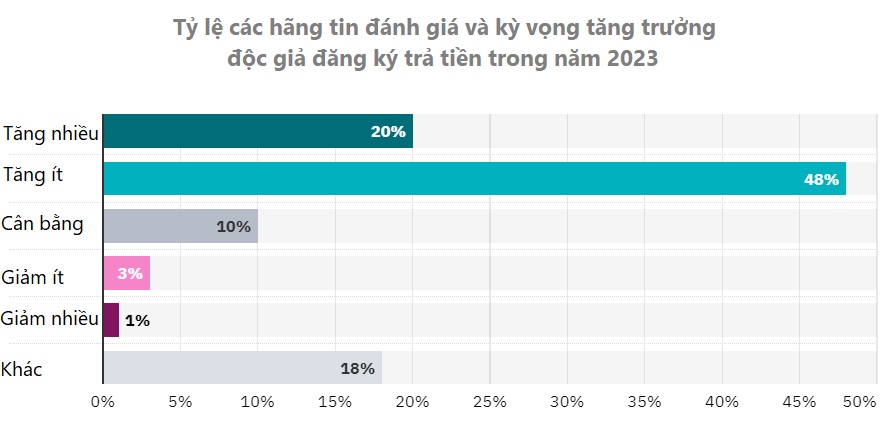World press and the journey to win back readers The world economy with inflation and global recession has negatively affected the life of the world press. However, to survive, the press is still determined and persistent in its journey to win and retain readers. How has that journey been and is taking place? What new strategies, directions and models are the world press applying to "win readers"?... is the story raised in the topic "World press and the journey to win back readers". |
Reality is still difficult
This time last year, not long after the Russia-Ukraine conflict, a global economic crisis occurred, leading to a series of secondary crises in energy, finance, food, inflation, etc. in most countries. Most people in the world, including in prosperous countries in Europe and North America, had to “tighten their belts” on even the most essential expenses, let alone spending on journalism.
All of this has caused the world's press, which was already "stunted" after being suffocated by technology platforms and social networks, as well as the COVID-19 pandemic, to continue to face a precarious reality and a more uncertain future.
As the economy has slowed, advertisers have cut back, and news organizations have faced rising costs across the board. Newsrooms that rely heavily on print have been hit particularly hard, with paper costs doubling in some areas. It has been a devastating blow, and has even effectively ended the lives of a number of print newspapers.
In the US, the Gannett media group has cut another 6% of its news division, losing about 200 employees. The Washington Post has stopped publishing its 60-year-old print magazine. CNN has laid off hundreds of people, and the US radio and television network NPR has significantly cut costs and staff due to financial shortfalls. The picture is probably similar in many countries around the world, including Vietnam.

The press is gradually finding new ways to survive and develop even in the most difficult times. Photo: GI
Not only print newspapers, but also online newspapers that were once very successful in the “free digital era” have declined or even collapsed rapidly, notably the case of BuzzFeed closing its Pulitzer Prize-winning news site. BuzzFeed is not alone in the decline of those who still try to survive in the free digital era. Another very famous digital media brand, Vice, is also following in this footsteps.
Then there are the once-popular news sites like Insider, Protocol, Morning Brew, and Vox, which are also laying off staff and entering a phase of decline. Traffic declines due to the “turning of the wheel” algorithms of social media platforms, especially Facebook, have complicated the problem, especially for news sites that have become too dependent on social media to distribute news.
Not only print and digital organizations, but also television stations are facing uncertainty due to rapidly declining audiences - across all age groups, due to the rise of online video sharing and broadcasting platforms. The reason continues to lie in the fact that most stations still rely too much on free viewers for advertising revenue, while advertisers and users have flocked to video sharing platforms or social networks.
Motivation from hardship
So, the traditional press and media industry is basically going down on its graph and even more urgently. But obviously, the press will not stand idly by in the face of the current dire situation and prospects. What can the press do to develop again, at least to stop the downward trend? Is there any solution?
Fortunately, the answer is yes. In theory, information is still a product that everyone needs, the important thing is that it must be valuable to them. That means, the press will have to create products that are valuable to society, in the region or even just in a small community, depending on the model and characteristics of the newspaper. As for how to achieve that, it is a long journey and there is no one-size-fits-all answer.

The press needs to continue to diversify the way it conveys information and become more qualitative in order to create works that are truly valuable to readers. Photo: GI
In fact, the trend of newspapers returning to the way they operated in the print era, where readers pay to buy newspapers, has been growing in popularity around the world in recent years, and is increasingly proving to be the way for newspapers to save themselves.
Premium news organizations in particular are seeing continued growth in digital subscriptions, paywalls and donations. “We added 70,000 subscribers in the last year,” said Edward Roussel, head of digital at The Times of London. Many other news organizations are also reporting strong growth in paywalls and subscriptions. At the New York Times alone, subscription revenue is up more than 10% and is on track to reach 15 million subscribers by 2027.
However, there is a growing concern that subscription growth may be nearing saturation, according to media consultancy FIPP. With winter approaching, we may be “feeling the chill of the freeze,” says FIPP chairman James Hewes. But according to experts and recent surveys, the paid subscription market in the newspaper market remains very promising in the short to medium term.
And according to the analysis and trends happening in the world, the immediate task of the news agencies in the world that are successful in the paid newspaper market is to focus more on retaining current readers than finding new subscribers. The reason is because of the above-mentioned “saturation” . However, for that reason, how to attract new readers and regain the trust of old readers is vital in the long-term future.
It's time to wake up and win back readers.
In other words, it is time for the press to wake up to regain old readers and find new readers. There is no doubt that this is a matter of life and death for the press in the future. Just like every other field in life, from a product line to an art form, the press only has a future if it is welcomed by a large number of readers, especially the younger generation.
But the important thing is how and how this journey should take place? First of all, it must be affirmed that this is also a big question mark, requiring the cooperation of everyone if we want to find specific solutions.
New HopesThe survey shows that newsrooms around the world are experiencing new dynamics in their search for readers willing to pay for their journalism. The data comes from a survey of 303 media leaders in 53 countries for the “News, Media and Technology Trends and Predictions 2023” by the Reuters Institute for Journalism and the University of Oxford.  |
However, there are some basic models of re-engagement that are successful around the world. The first is to offer discounts and special promotions to entice readers to subscribe to your articles. This is also very appropriate in the current context, when economic crisis and inflation still weigh heavily on the pockets of most people around the world.
The Washington Post is offering a 75% discount on its subscriptions by the end of 2022, while the LA Times and Chicago Tribune are offering six months of digital access for just $1. Other major publications include the New York Times, which typically offers $1 a week for the first year, and the Wall Street Journal, which is one of many newspapers offering discounted options for students.
This is considered a long-term strategy, as it can reduce the revenue of the newsrooms, but will attract the maximum number of potential readers who are willing to pay to read the newspaper. This tactic is being applied especially by European news agencies and is nurturing the hope that one day the press will flourish again when there is more motivation.
The good news for journalism is that, according to data from global trends research organization GWI, after decades of steady growth, we are starting to see a decline in the amount of time spent online, meaning that readers are generally moving towards something more qualitative and less “chaotic” . Specifically, total time spent online has dropped by 13%, after a record increase during the COVID-19 pandemic. This is a very important change for journalism to grasp.
According to a survey by the Reuters Institute of Journalism and the University of Oxford, some 42% of news organizations reported an increase in annual traffic to their websites, with 58% reporting that traffic was flat or declining. These figures are not definitive, but they do suggest that the future is not all bleak.
The reality that many people can recognize is that readers have begun to be fed up or scared of the "sensational" , "pushing" , "addictive" , "toxic" and especially "misleading" information sources that are rampant on social networks. They are willing to return to the press, as long as the press is really good enough and has many suitable solutions to help readers easily access.
Leveraging technology and improving quality
That means journalism needs to be better, more diverse, more flexible, more engaging and more insightful. Like a commodity, journalism needs to have its own identity to attract readers. In a recent study, media consultancy INMA found that 72% of news brands have started to develop their own journalism positioning strategy or principles.
La Vanguardia in Spain has emphasized the phrase “truth is the first victim of war” when selling subscriptions. Vox Media emphasizes its mission of being available to inform its readers. The Guardian emphasizes its courageous, independent journalism. Let newspapers create their own slogans and do their jobs well.
Unique doesn’t mean lacking variety. The variety here is in the way information and sources are presented, how to make it most appealing to readers. The New York Times now offers a bundle that combines news with cooking apps, games, and other useful services. That means when you subscribe, readers get more than just news.
In Norway, the leading daily Aftenposten offers a free access package to other national and regional newspapers with which it is affiliated or collaborates. Diversifying revenues and products remains a top priority for news publishers around the world. In short, journalism cannot stand still, not even for a day, in the digital age and the coming age of artificial intelligence (AI).
To become more diverse and attractive, newspapers that want to succeed also need to continue to invest in technology. Good use of Big Data and AI will help newsrooms understand their readers better, thereby meeting their needs. News forms also need to be more attractive and technologically rich, through algorithms, new formats, from podcasts, videos, live, email, applications... and other software that automatically sends news to readers.
So, although the world of journalism and media in general is still going down on its graph, it seems to be at the bottom of a sine curve. If we know how to take advantage of the opportunity, journalism can completely break out again and open a new cycle of success!
Hai Anh
Source




![[Photo] Visiting Cu Chi Tunnels - a heroic underground feat](https://vstatic.vietnam.vn/vietnam/resource/IMAGE/2025/4/8/06cb489403514b878768dd7262daba0b)















![[Infographic] Cu Chi Tunnels - Underground Village](https://vstatic.vietnam.vn/vietnam/resource/IMAGE/2025/4/8/d69d9caa3f89479c809867b18bacfefb)





































































Comment (0)